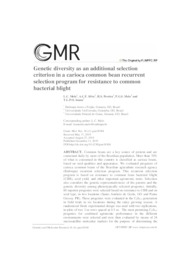Genetic diversity as an additional selection criterion in a carioca common bean recurrent selection program for resistance to common bacterial blight.
Genetic diversity as an additional selection criterion in a carioca common bean recurrent selection program for resistance to common bacterial blight.
Author(s): MELO, L. C.; SILVA, A. C. F.; PEREIRA, H. S.; MELO, P. G. S.; SOUZA, T. L. P. O.
Summary: Common beans are a key source of protein and are consumed daily by most of the Brazilian population. More than 70% of what is consumed in this country is classified as carioca beans, based on seed qualities and appearance. We evaluated progenies of carioca common beans of the Brazilian agriculture research agency (Embrapa) recurrent selection program. This recurrent selection program is based on resistance to common bean bacterial blight (CBB), seed yield, and other important agronomic traits. Selection also considers the genetic representativeness of the parents and the genetic diversity among phenotypically selected progenies. Initially, 60 superior progenies were selected based on resistance to CBB and on seed type, in two locations (Santo Antônio de Goiás, GO and Ponta Grossa, PR). These progenies were evaluated in the C0S0:2 generation in field trials in six locations during the rainy growing season. A randomized block experimental design was used with two replications, in plots of two 3-m rows spaced at 0.5 m. The most promising C0S0:3 progenies for combined agronomic performance in the different environments were selected and were then evaluated by means of 24 microsatellite molecular markers for the purpose of determining the genetic representativeness of their parents and the genetic diversity among them. The phenotypic data was subjected to analysis of variance for each trait in each of the environments, and then joint analyses were performed. To estimate genetic diversity among the progenies, the Rogers-W genetic distance was used, and a dissimilarity matrix was used to construct a dendrogram of genetic distances through the UPGMA method. Among the 60 C0S0:2 progenies that were evaluated, those that stood out for resistance to CBB also stood out for seed yield and for resistance to other diseases. Various progenies were superior, exhibiting large genetic distances between each other and in relation to the parents. This indicates a possibility of direct and indirect gains from the recurrent selection program. This molecular information will help direct selection of individuals for future recombination cycles.
Publication year: 2019
Types of publication: Journal article
Unit: Embrapa Rice & Beans
Observation
Some of Embrapa's publications are published as ePub files. To read them, use or download one of the following free software options to your computer or mobile device. Android: Google Play Books; IOS: iBooks; Windows and Linux: Calibre.
Access other publications
Access the Agricultural Research Database (BDPA) to consult Embrapa's full library collection and records.
Visit Embrapa Bookstore to purchase books and other publications sold by Embrapa.

